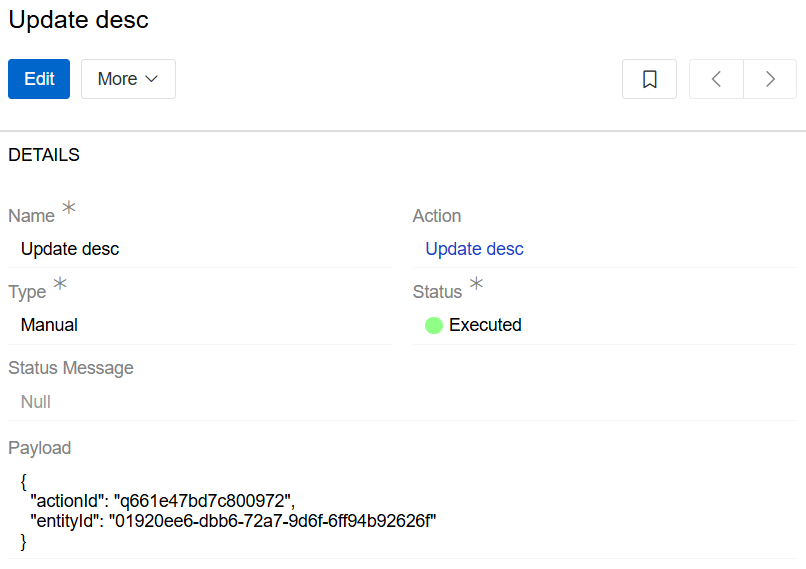Actions in AtroCore are automated operations that can be executed manually through the user interface or automatically via scheduled jobs and workflows. They provide a powerful framework for automating business processes, data transformations, integrations, and AI-powered operations.
Key Features
- Flexible Execution: Actions can be triggered manually, automatically via workflows, or through scheduled jobs
- Entity-Specific: Actions can be configured to work with specific entities (Products, Files, etc.)
- User Context: Actions can execute as the system user or maintain the same user context
- Conditional Logic: Actions support both basic and script-based condition types
- Data Integration: Seamless integration with import feeds and export feeds
Creating and Configuring Actions
Accessing Actions
Navigate to Administration > Actions to manage all configured actions in your system.
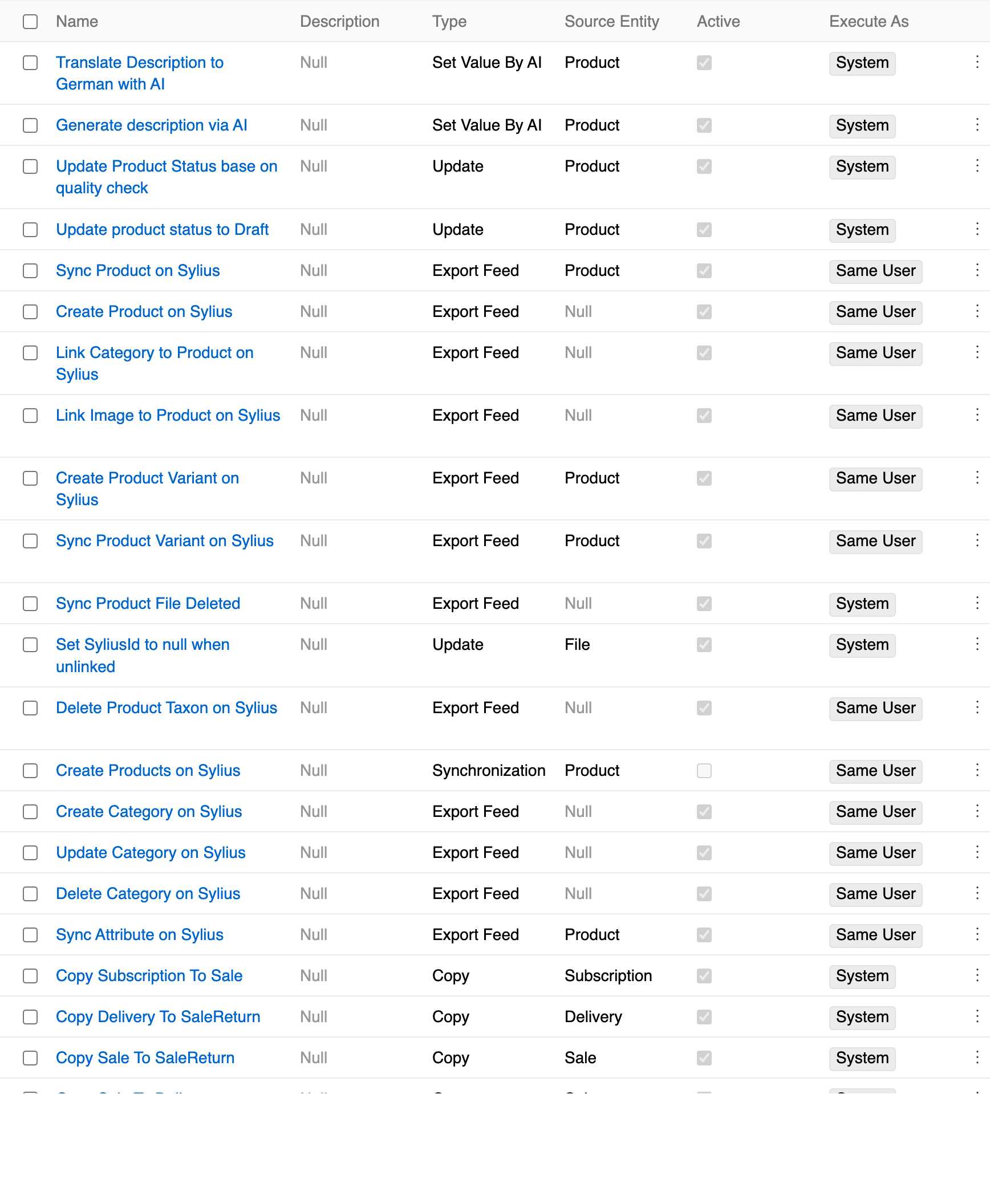
Basic Configuration
All actions share these common configuration fields:
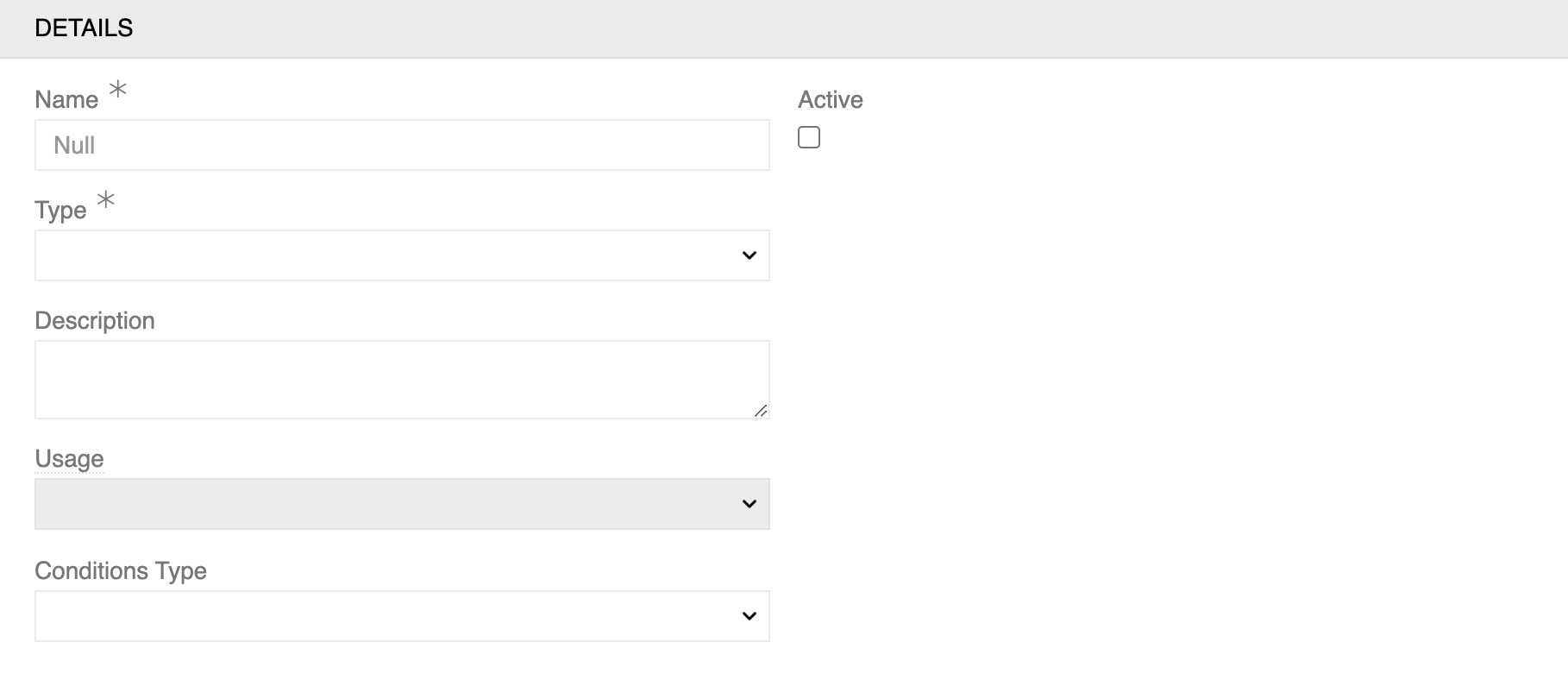
- Name: Descriptive name for the action
- Type: The specific action type (see Action Types section below)
- Usage: Defines the action scope. Some usage types are applicable only to specific action types:
- Entity action button: Applies to entire entity types
- Record action button: Applies to individual records
- Field action button: Applies to specific entity fields
- On record load: Applies to individual records when the page loads
- Conditions Type: How conditions are evaluated:
- Basic: Simple condition builder
- Script: Custom script conditions following Twig syntax
- Active: Whether the action is enabled
- Execute As: User context for execution:
- System: Runs with system privileges
- Same User: Maintains the triggering user's context
When Usage is selected (any non-empty option), an additional Source Entity field appears to specify which entity the action targets.
Entity action button:
- Display (Single, Dropdown): Defines how the action button appears on the list view header.
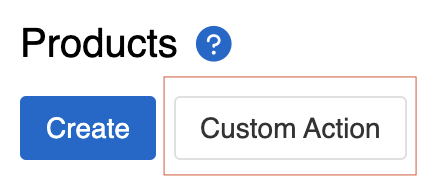
Single shows a direct button on the list view header.
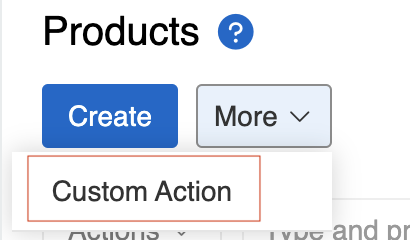
Dropdown groups the action in a dropdown menu.
Record action button:
- Display (Single, Dropdown): Defines action button on detail view (also available as single record action in list view)

Single shows a direct button on the detail view.
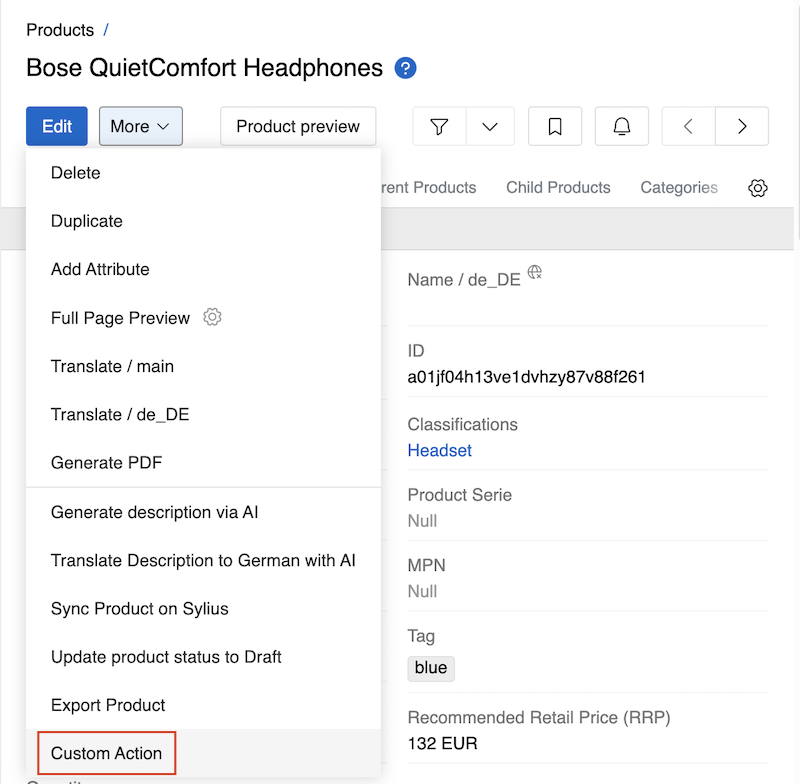
Dropdown groups the action in a dropdown menu on the detail view.

Actions are also available as single record actions in list views.
- Mass actions: Checkbox to determine if the action will be available as mass action
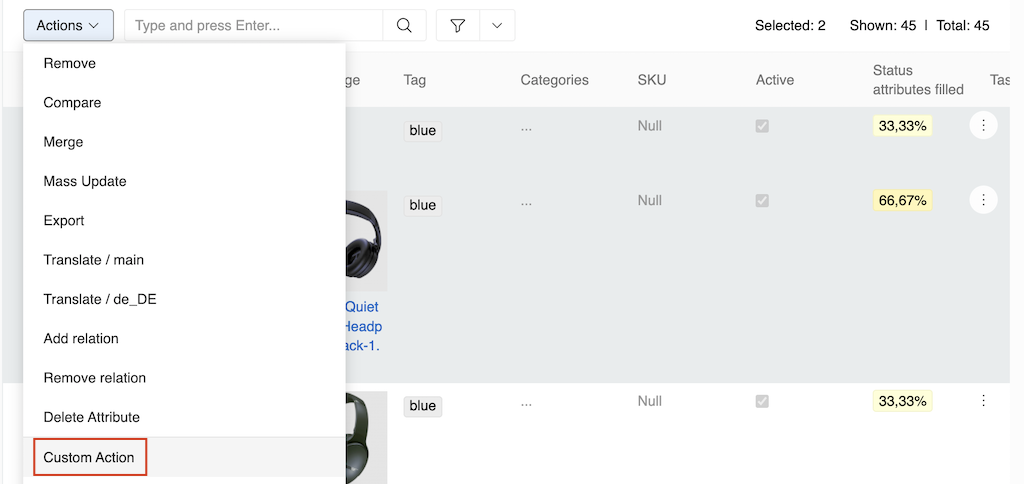
When enabled, actions appear in the mass actions menu for selected records. Read Mass actions for more information.
Field action button:
- Field: Defines which field the action button will be shown near on detail view
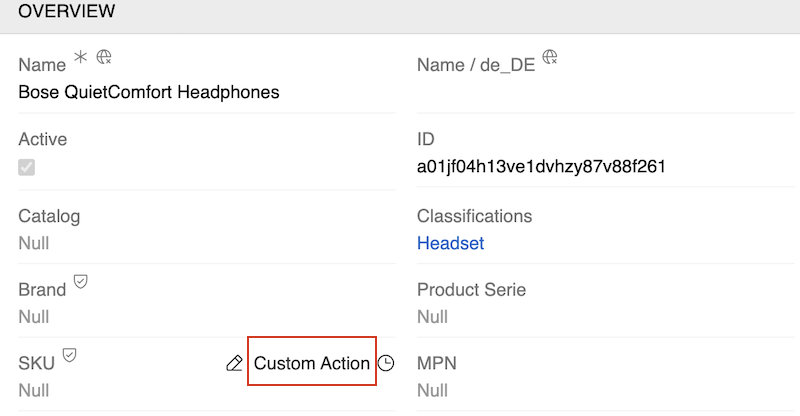
Field action buttons appear as buttons next to specific fields on detail pages and are shown when you hover over the field.
Executing Actions
Manual Execution
Actions can be executed manually through the user interface:
- Direct execution: Use the Execute button available on the action's detail page
- Entity-level actions: Available on list view headers based on Display configuration
- Record-level actions: Available on detail pages and as single record actions in list views
- Field-level actions: Available as buttons next to specific fields on detail pages
- Mass actions: Available for multiple selected records when Mass Action is enabled
Automatic Execution
Actions can be triggered automatically through:
- Workflows: Event-driven execution based on entity changes
- Scheduled Jobs: Time-based execution at regular intervals
Monitoring Actions
Use Job Manager and Action History in Administration to monitor action execution and track their results. For some Action Types, such as Import Feed, Export Feed you should be able to view executions from the related Feed record as well.
Action Types
AtroCore supports various action types, each designed for specific automation scenarios. Below are all available action types and their configurations:
Some action types are available only with additional modules purchase.
Data Operations
Create
Creates new records in the system based on defined templates.

Configuration:
- Target Entity: Entity type for new records
- Update Type: Method for record creation (Basic or Script)
Basic Mode: When using "Basic" update type, an Update panel becomes available after saving the action, allowing you to configure the field values for new records.

- Use Select Field to add new fields to the creation template
- Set specific values for each field that will be applied to all created records
- Required fields are marked with an asterisk (*)
Script Mode: When using "Script" update type, field values are defined through JSON code:

- Define field values using JSON syntax with key-value pairs
- Support for Twig templating syntax using
{{ entity.fieldName }}expressions - All configuration is done in the Script field
- Provides flexibility for complex field mapping and dynamic values
Update
Modifies existing records based on specified criteria and field values.
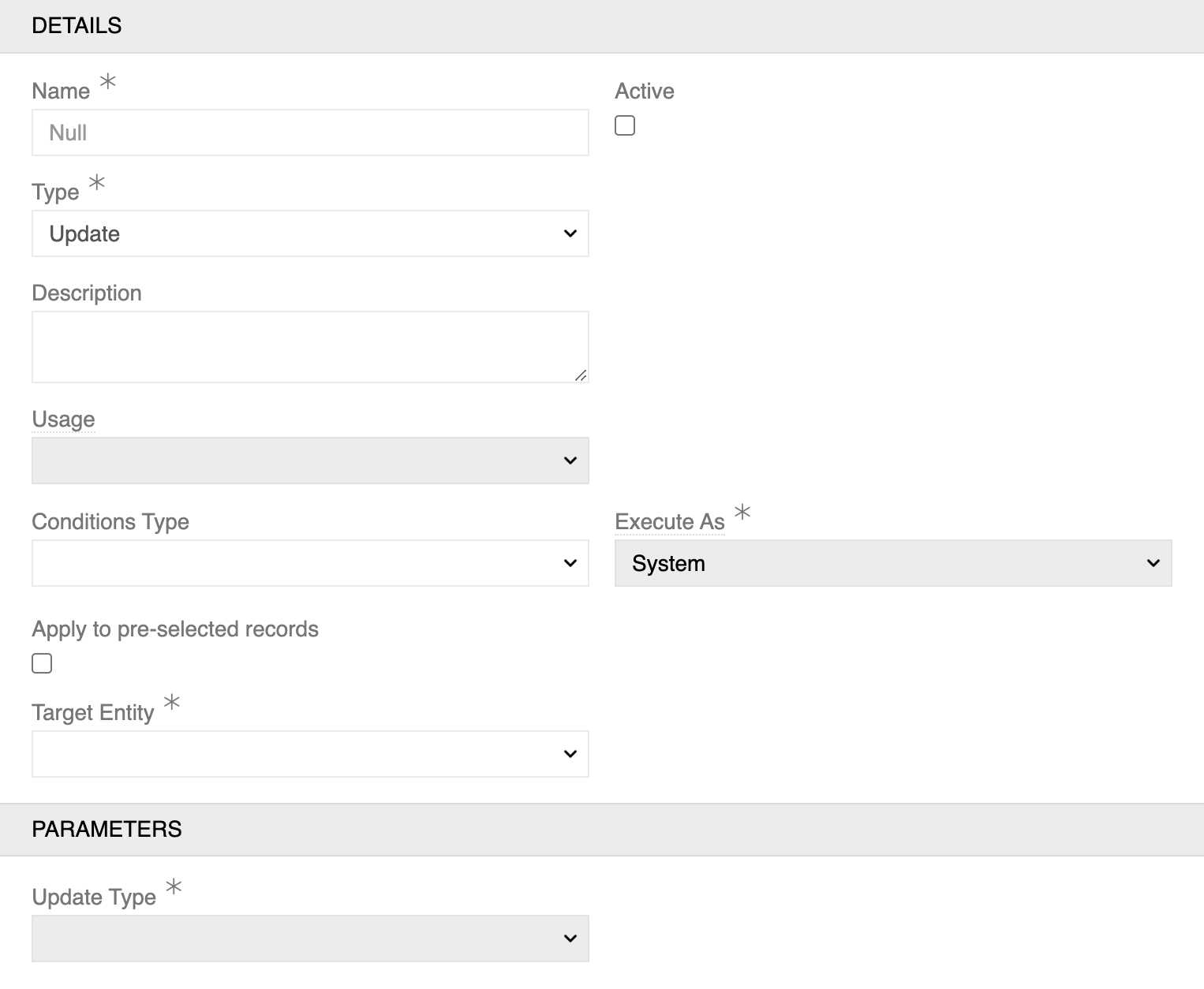
Configuration:
- Target Entity: Entity type for records to update
- Update Type: Method for record updating (Basic or Script)
- Apply to pre-selected records: Defines the action scope:
- Checked: Action operates only on the specific record it was triggered from. Source Entity becomes locked to match Target Entity, and Filter Result panel is not available.
- Unchecked: Action can target different entities and use filtering criteria. For example, Source Entity can be "Brand" while the action updates all "Products" associated with that brand.
- Filter Result: Available only when "Apply to pre-selected records" is unchecked. Define which records should be updated based on specific criteria and query conditions - see Search and Filtering for details
Basic Mode: When using "Basic" update type, an Update panel becomes available after saving the action, allowing you to configure the field values for new records.

- Use Select Field to add new fields to the creation template
- Set specific values for each field that will be applied to all created records
- Required fields are marked with an asterisk (*)
Script Mode: When using "Script" update type, field values are defined through JSON code:

- Define field values using JSON syntax with key-value pairs
- Support for Twig templating syntax using
{{ entity.fieldName }}expressions - All configuration is done in the Script field
- Provides flexibility for complex field mapping and dynamic values
Upsert
Creates new records or updates existing ones based on matching criteria.

Configuration:
- Script: JSON configuration defining entity mappings and field values
- Uses array syntax with entity/payload structure
- Support for Twig templating in payload values
Example JSON Configuration:
[{"entity":"Product","payload":{"name":"{{ entity.name }}"}}]Suggest value
Suggests modifications for existing records based on defined templates. The user can then modify the result. These suggested values only appear in the front end and must be saved manually.

Configuration:
- Source Entity: Entity type for records
- Update Type: Method for record updating (Basic or Script)
This action type is only visible when editing records or using inline editing for the Focus Field.
Basic Mode: When using "Basic" update type, an Update panel becomes available after saving the action, allowing you to configure the field values for new records.

- Use Select Field to add new fields to the creation template
- Set specific values for each field that will be applied to all created records
- Required fields are marked with an asterisk (*)
Script Mode: When using "Script" update type, field values are defined through JSON code:

- Define field values using JSON syntax with key-value pairs
- Support for Twig templating syntax using
{{ entity.fieldName }}expressions - All configuration is done in the Script field
- Provides flexibility for complex field mapping and dynamic values
When using Script Mode for Suggest value action additional twig functions are available:
- "uiRecord": Record data array. Variable contains data that you have on frontend side,
- "uiRecordFromName": The name of the entity from which you open current entity,
- "uiRecordFrom": Record data array of the entity from which you open current entity.
Suggest value by AI
This is an action added by AI Integration module. It uses the same method as Suggest value action type but uses AI for the suggested data. For more information please read AI Integration documentation page.
Set value by AI
This is an action added by AI Integration module. It uses the same method as Update action type but uses AI for the suggested data. For more information please read AI Integration documentation page.
Delete
Removes records from the system based on specified criteria.
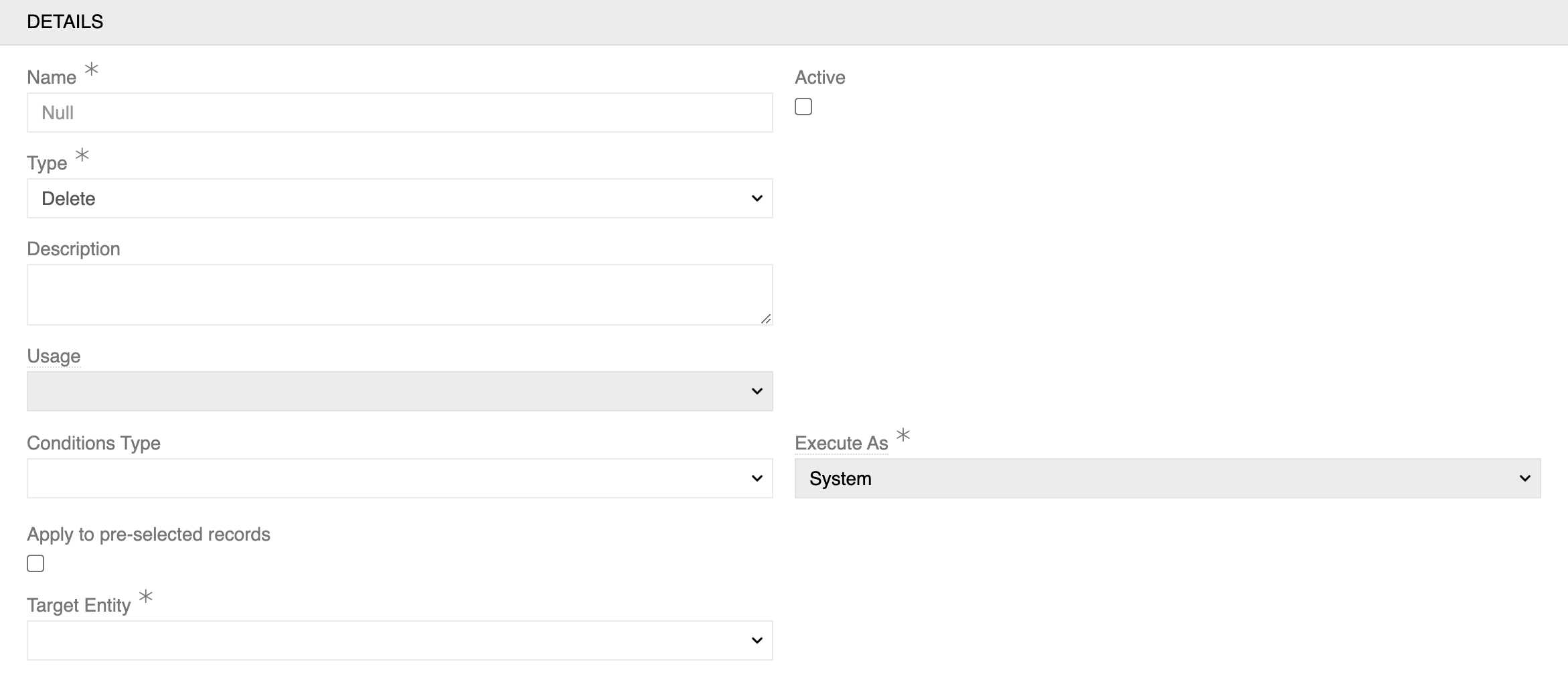
Configuration:
- Target Entity: Entity type for records to delete
- Apply to pre-selected records: Defines the action scope:
- Checked: Action deletes only the specific record it was triggered from. Source Entity becomes locked to match Target Entity, and Filter Result panel is not available.
- Unchecked: Action can target different entities and use filtering criteria. For example, Source Entity can be "Category" while the action deletes all "Products" filtered by that category.
- Filter Result: Available only when "Apply to pre-selected records" is unchecked. Define which records should be deleted using query conditions - see Search and Filtering for details
Copy
Duplicates existing records to create new copies.
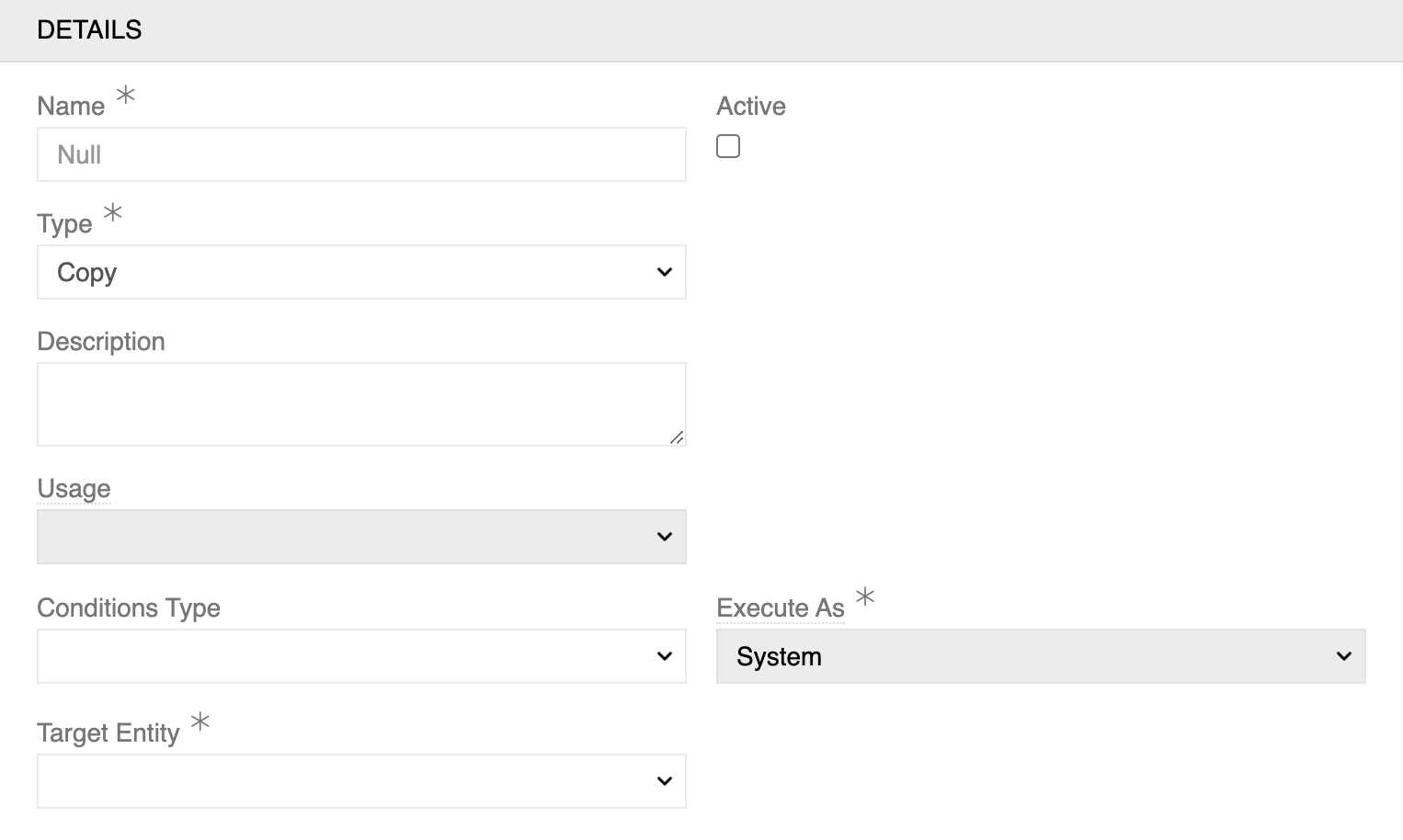
Configuration:
- Target Entity: Entity type to copy
Data Exchange
Webhook
Sends HTTP requests (GET) to external systems for integration purposes.
While this action type can organize outgoing webhook calls, consider using Export Feeds instead for more flexible and powerful outbound HTTP integration.

Configuration:
- URL: Target endpoint for the webhook request
Import Feed
Imports data from external sources using configured import feeds.
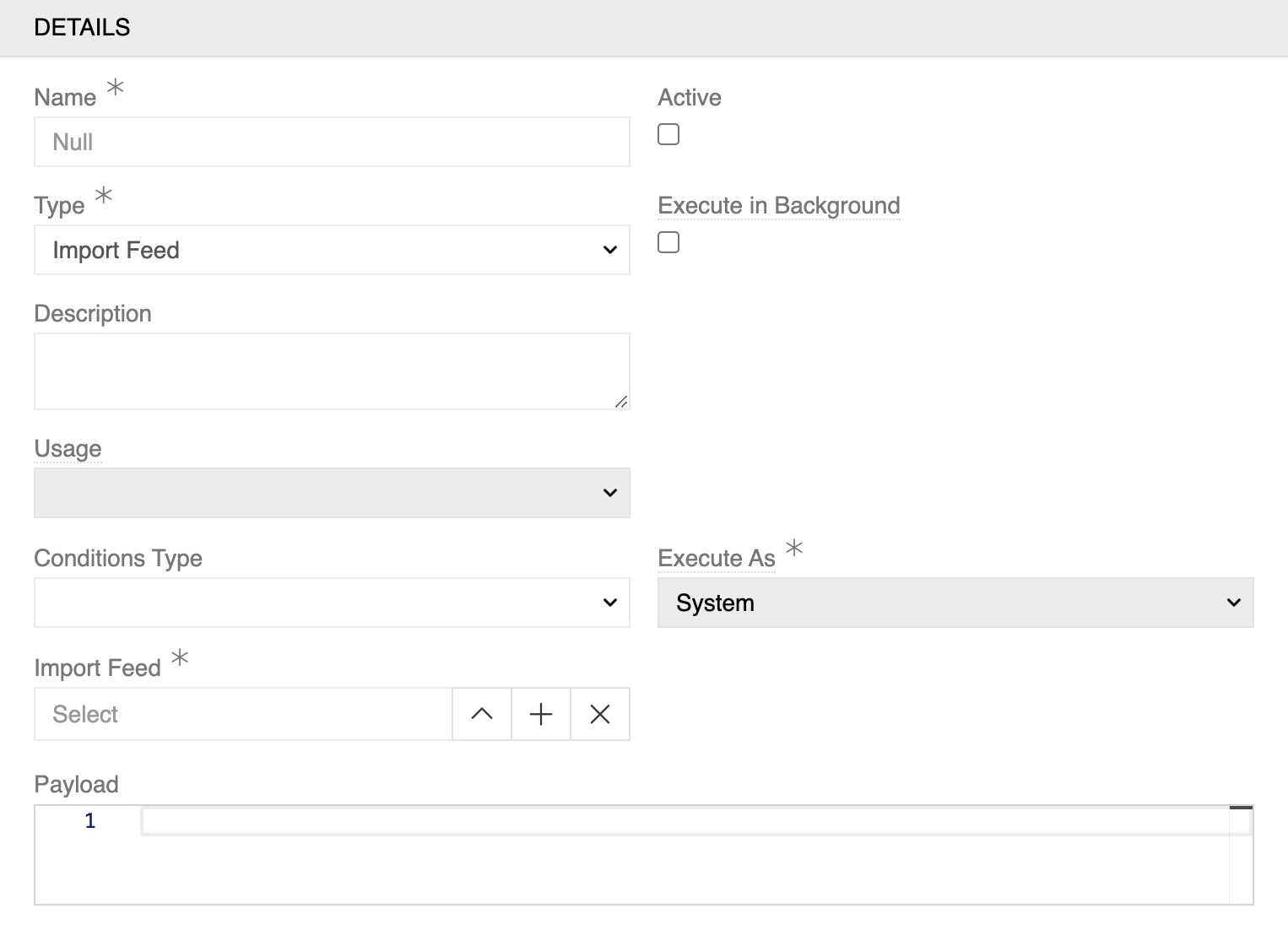
Configuration:
- Execute in Background: Option to run import as background process
- Import Feed: Selection of configured import feed
- Payload: Custom data payload for the import with Twig templating syntax
Export Feed
Exports data to external destinations using configured export feeds.
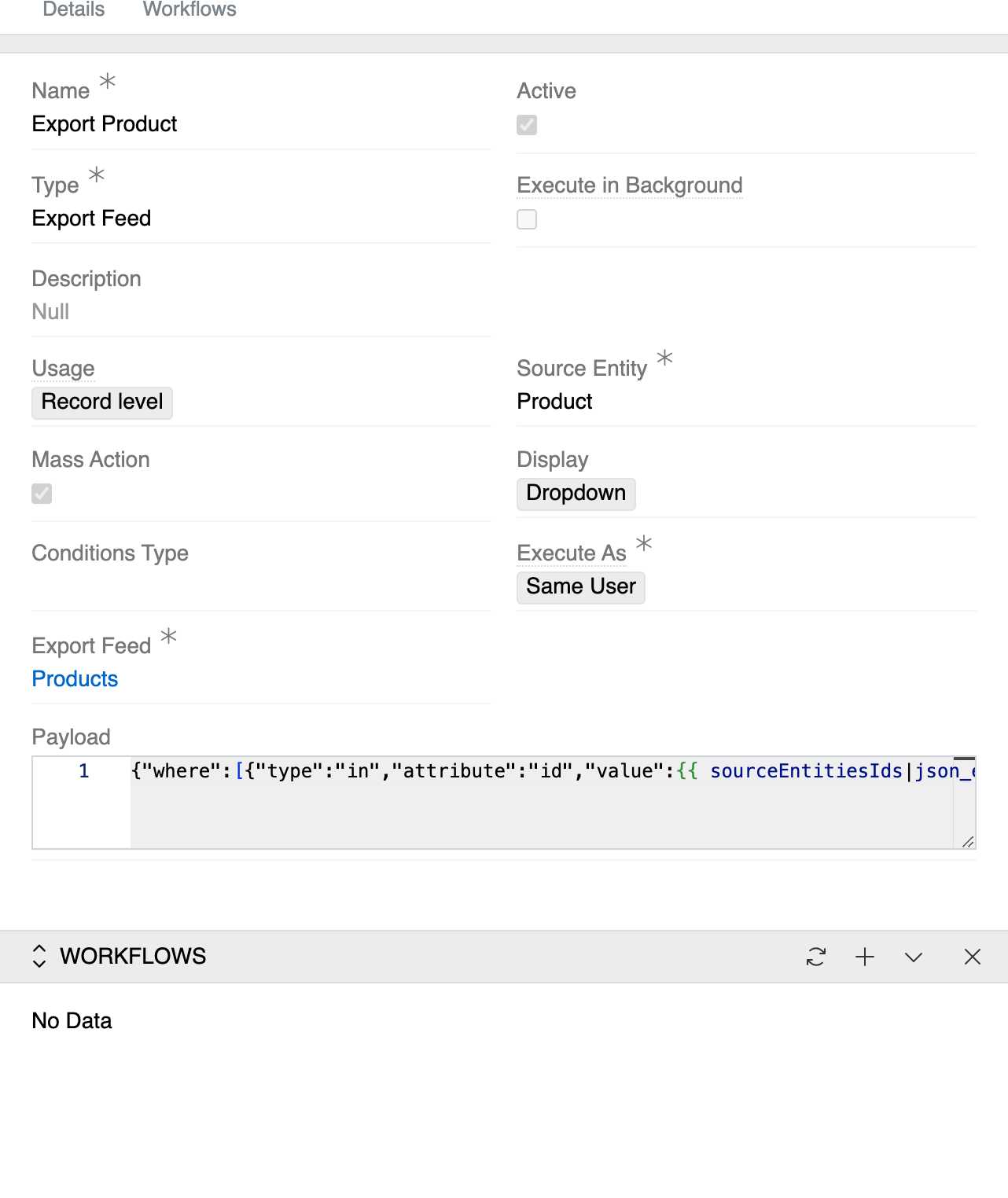
Configuration:
- Execute in Background: Option to run export as background process
- Export Feed: Links to a specific Export Feed entity that defines the export format, destination, and data mapping
- Payload: Custom data payload for the export with Twig templating syntax
Synchronization
Available with Synchronization module
Synchronizes data between AtroCore and external systems.
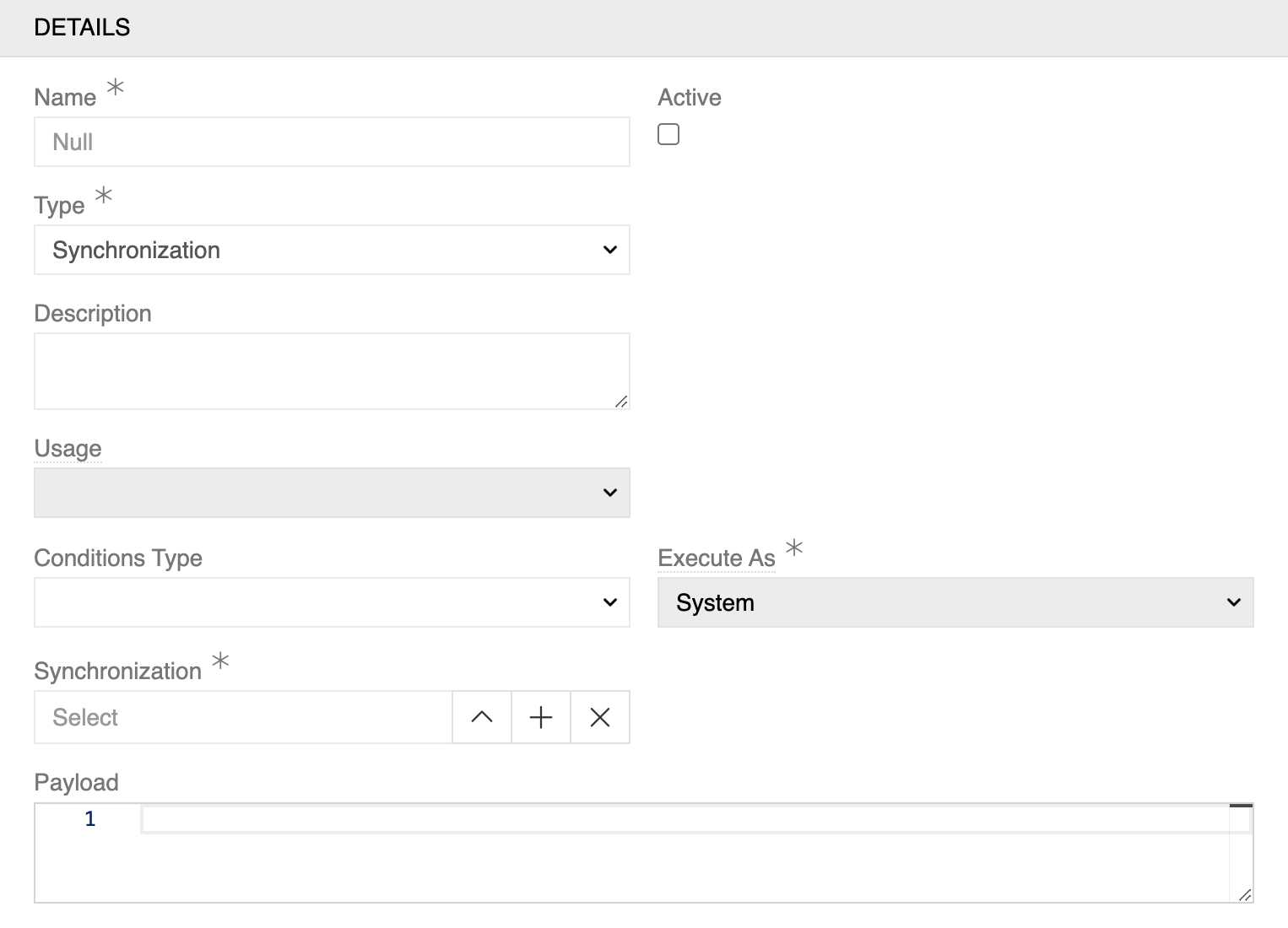
Configuration:
- Execute in Background: Option to run sync as background process
- Synchronization: Selection of configured synchronization
- Payload: Custom data payload for the synchronization with Twig templating syntax
Communication
Send E-mail
Sends emails to specified recipients using configured email templates and connections. Can be used to notify users about events related to the selected entity in response to some trigger actions (modification, creation or deletion of a new record, change of a certain field, etc.)
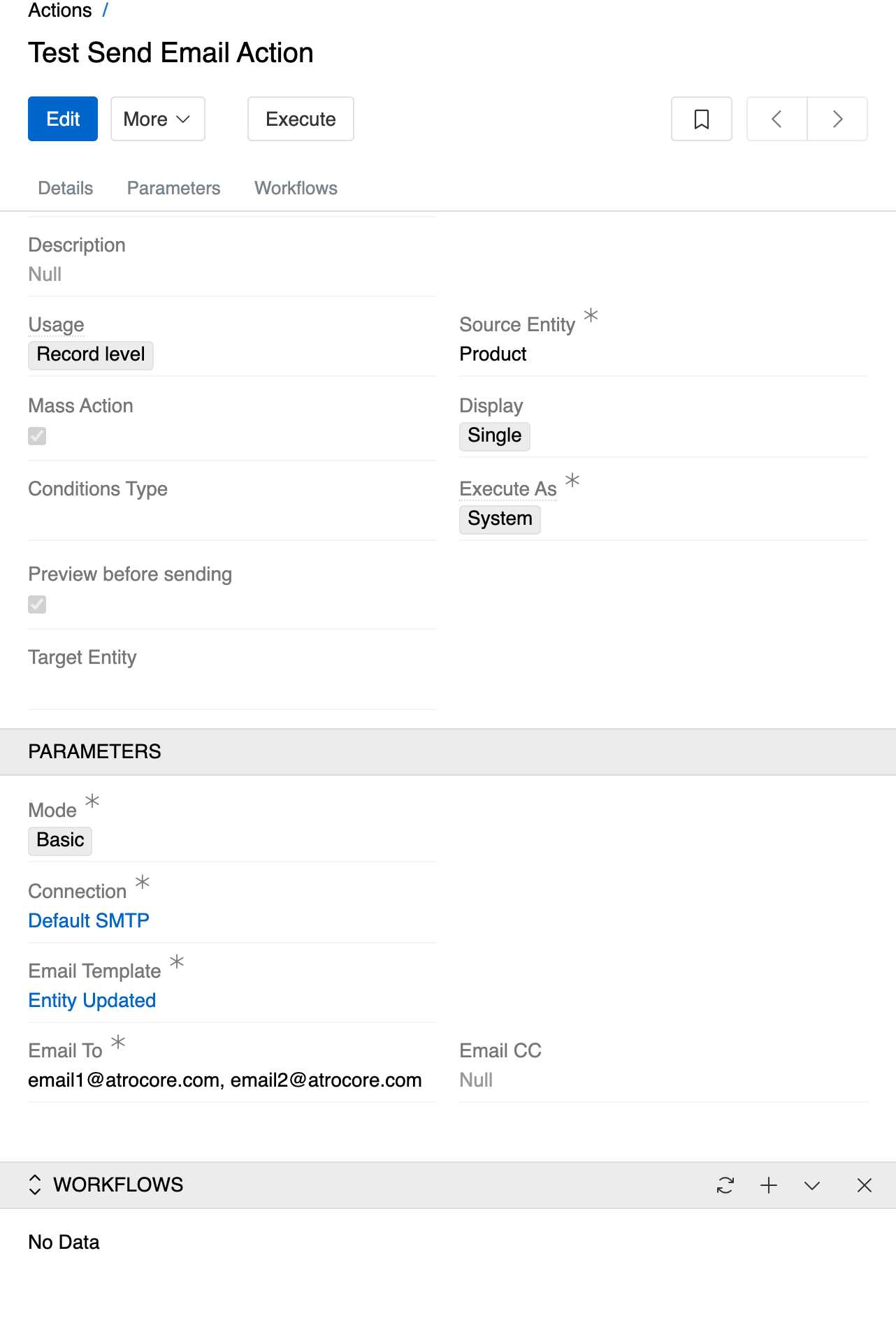
Configuration:
- Target Entity: Entity type that contains recipient information
- Preview before sending: Option to review email content before sending
- Mode: Email composition method (Basic or Script)
- Connection: Email server connection configuration (required) - links to configured SMTP connections
Basic Mode:
- Email Template: Email template for content and formatting (required) - links to Email Templates, you can choose existing template or create your own
- Email To: Primary email recipients (supports multiple addresses)
- Email CC: Carbon copy recipients (optional)
Script Mode:
Script mode provides advanced email configuration using Twig templating syntax.
 For example, you can send an email to all users who are related to the particular record or select a template depending on the kind of changes.
For example, you can send an email to all users who are related to the particular record or select a template depending on the kind of changes.
- Script: Code editor for dynamic email configuration with Twig variables:
emailTo: Array of recipient email addresses (e.g.,['email1@domain.com', 'email2@domain.com'])emailCc: Array of CC recipient email addresses (can be empty:[])emailTemplateId: ID of the email template to use (e.g.,'some-id')
Send Notification
Sends internal system notifications to users within the AtroCore application.
Can be used to send notifications to any users of the system in response to a specific trigger (record modification, changing of the specific field, etc.). You can select a specific user from the list of all system users, as well as select users associated with a specific entity.
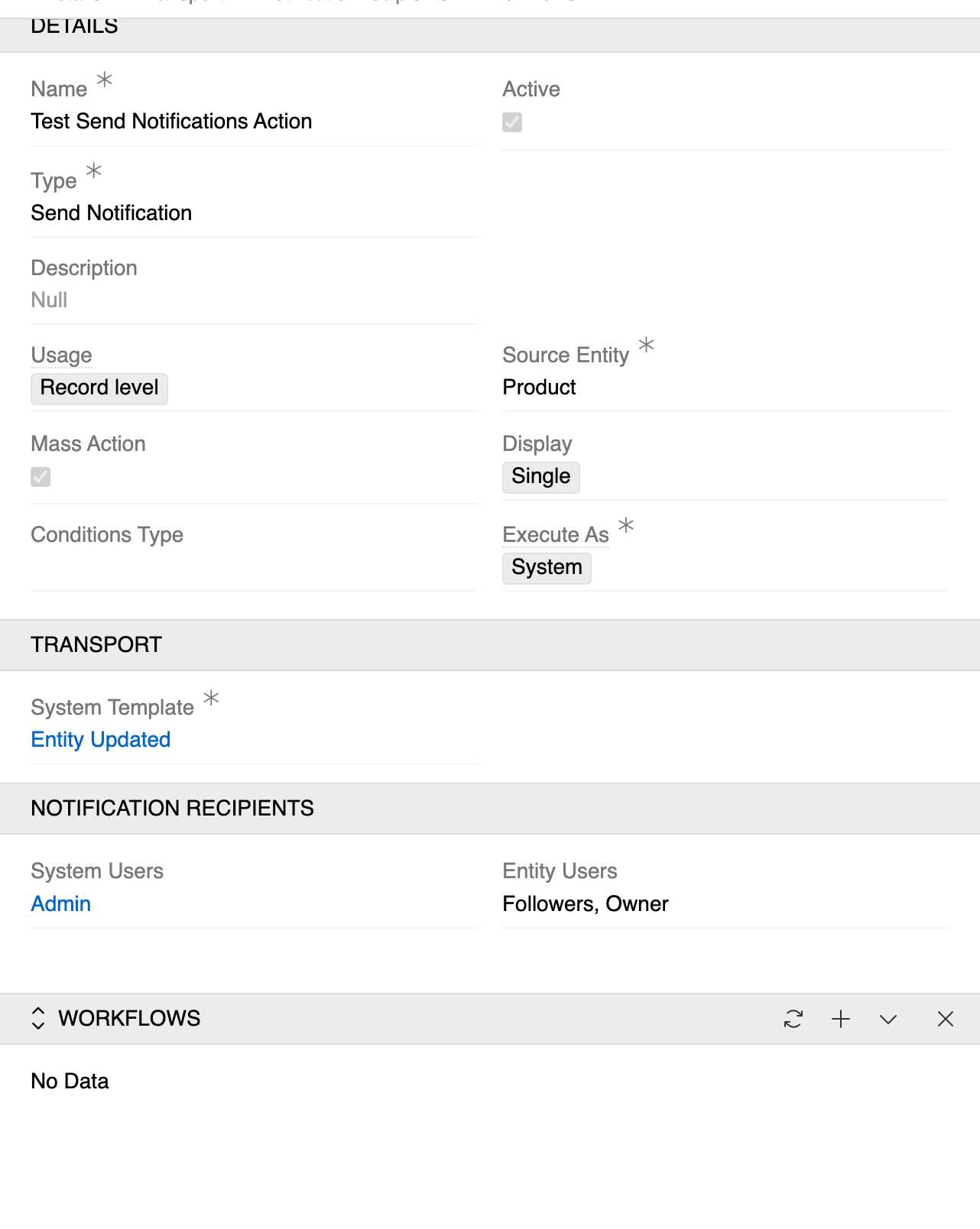
Configuration:
- System Template: Notification template (required) - links to Notification Templates. You can choose any of the pre-configured templates or create your own
- System Users: Specific users to receive notifications - links to Users
- Entity Users: Role-based recipients related to the entity record. The list of available fields depends on the entity selected in the Source Entity field. All user-related fields from the selected entity are presented here (Owner, Assigned User, Followers, etc.)
Notifications can have flexible recipients. This can be achieved using script mode and determine the user ID:

Here is an example of a script that determines the user ID:
{% set ids = [] %}
{% for team in entity.categories[0].teams ?? [] %}
{% for user in team.get('users') %}
{% set ids = ids | merge([user.id]) %}
{% endfor %}
{% endfor %}
{ "notificationSystemTemplateId" : "systemUpdateEntity", "usersIds": {{ids|json_encode|raw}} }Get MS E-mails
This is an action added by Microsoft 365 Connector module. It downloads emails from your Microsoft mailbox and saves them in Emails entity. For more information please read Microsoft 365 Connector documentation page.
Document Generation
Generate PDF
Available with PDF Generation module.
Creates PDF documents using configured PDF templates.
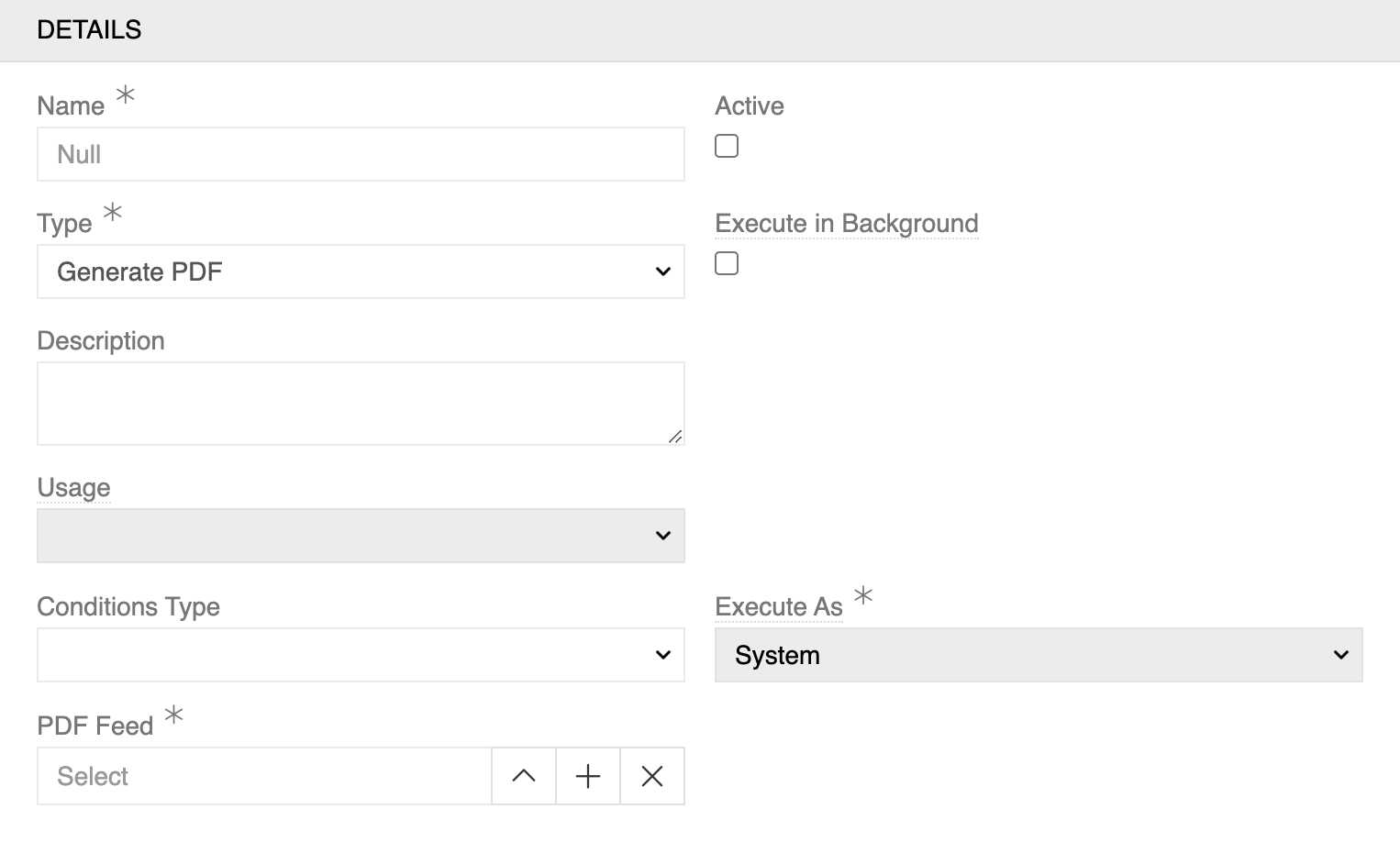
Configuration:
- PDF Feed: Selection of configured PDF template
Utility Actions
Error Message
Displays custom error messages to users when executed.
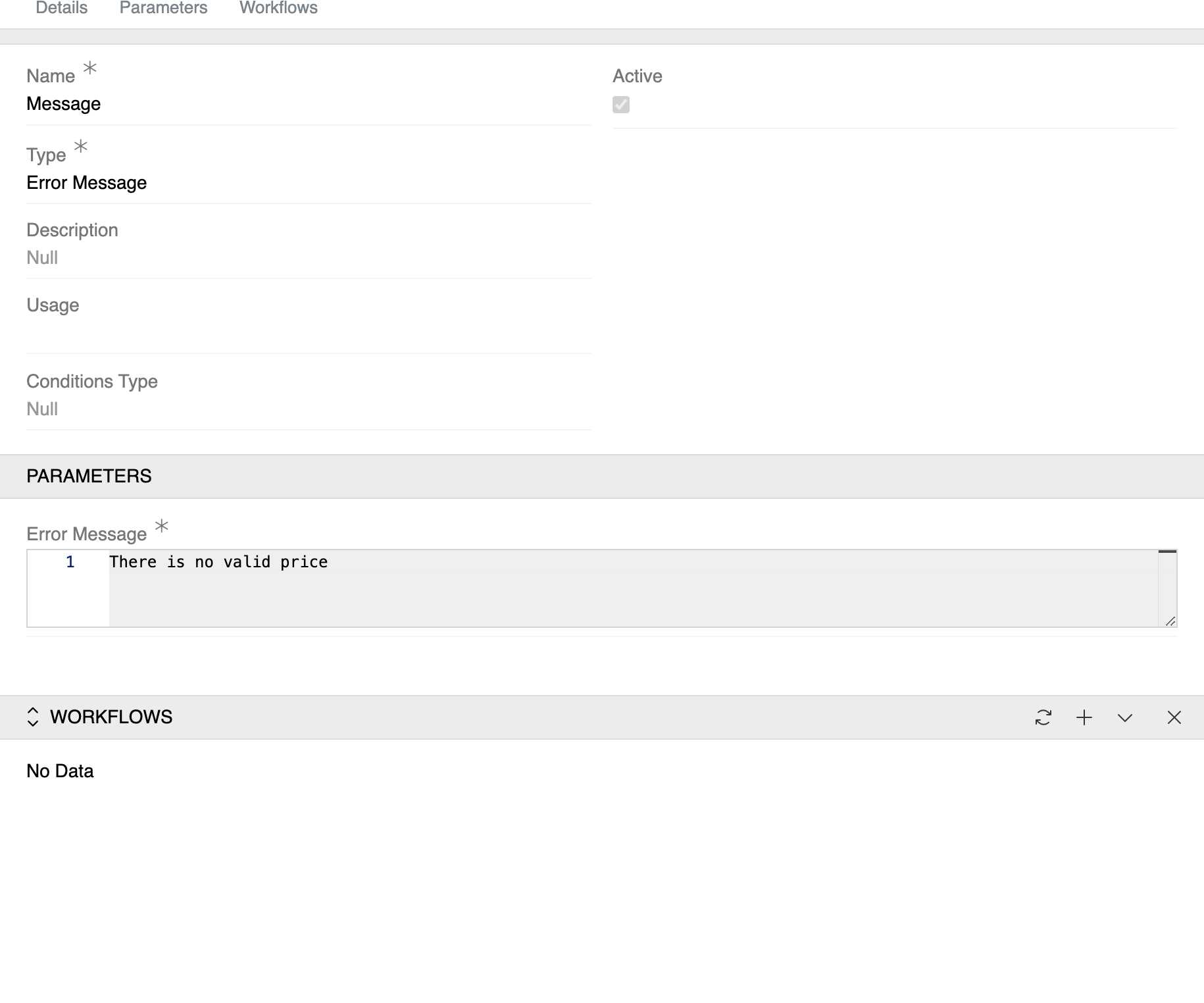
Configuration:
- Error Message: Text content for the error message (supports dynamic content with Twig syntax)
This action is typically used within Workflows for conditional error handling. It is usually set up with an empty Display field so it does not appear as an action button, and the error message is shown whenever the action is triggered in the workflow.
Validate Component
This is an action added by Components module. For more information please read Components documentation page.
Action Set
Groups multiple actions for sequential execution.
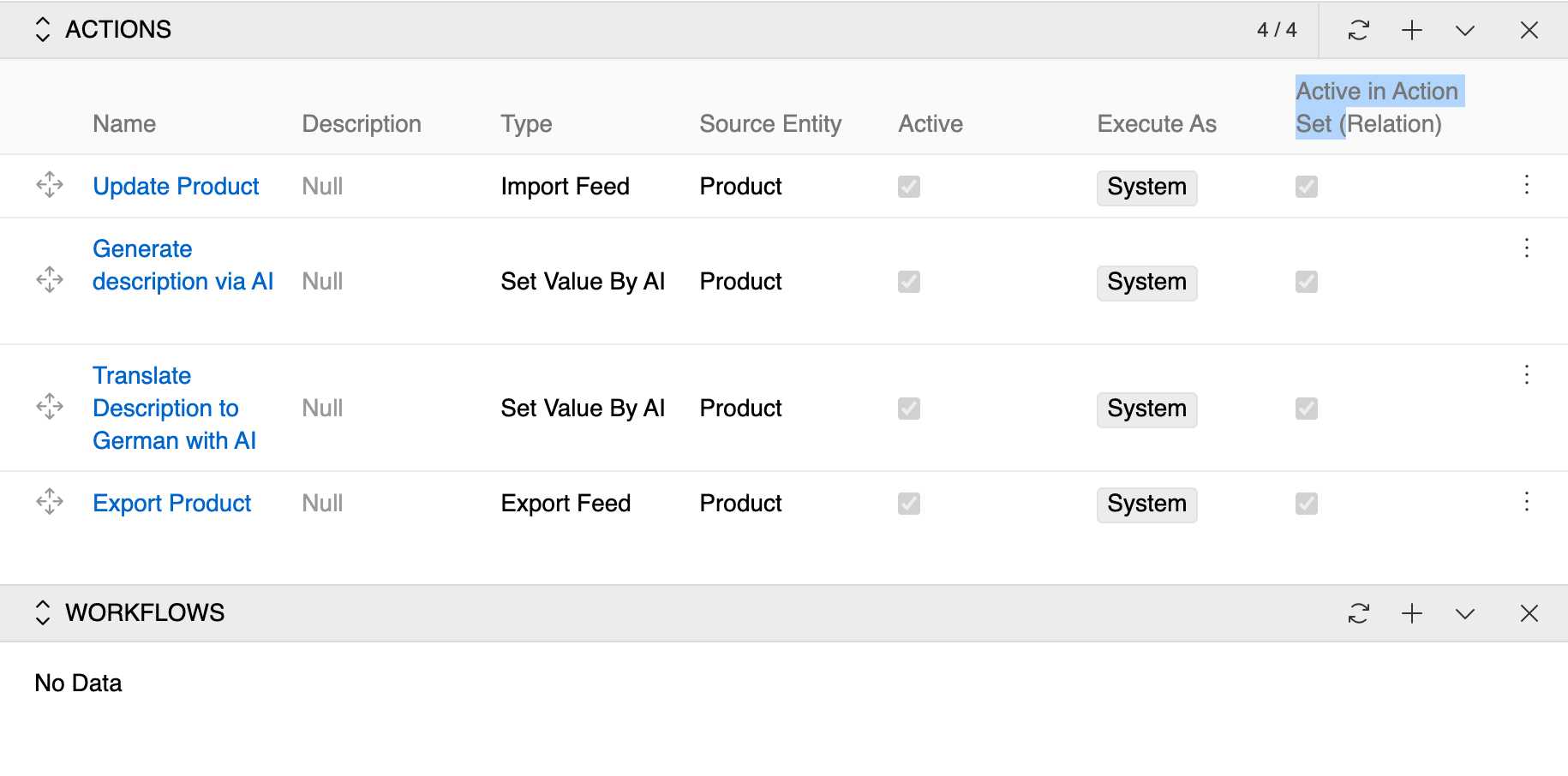
Configuration:
- Actions Panel: Displays all included actions with their details (Name, Type, Source Entity, etc.)
- Active in Action Set: Each action has a checkbox to control its participation in action sets
- Sequential Execution: Actions execute in the defined order when triggered
Use Cases:
- Execute multiple related actions as a single operation (e.g., AI content generation, translation, export)
- Temporarily disable specific actions for testing different scenarios
- Integrate complex workflows while maintaining control over individual components
Action Logs
The action entity has a log panel. All important information is displayed there, such as who called the action, when they did so and what data they used. This greatly helps developers with debugging and configuring the action.
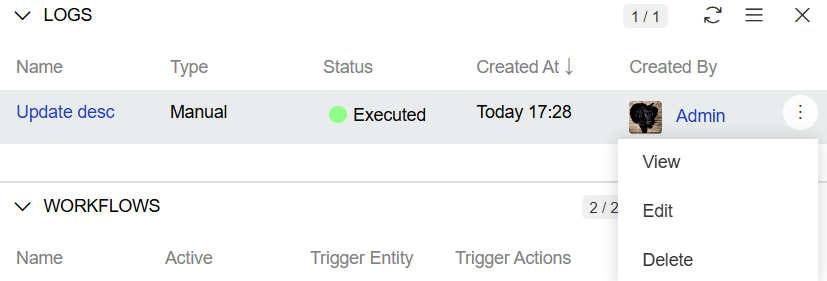
As with any other logs in AtroCore, action logs can be viewed, deleted and edited (but only the action name).
You can access a detailed view of any action.
